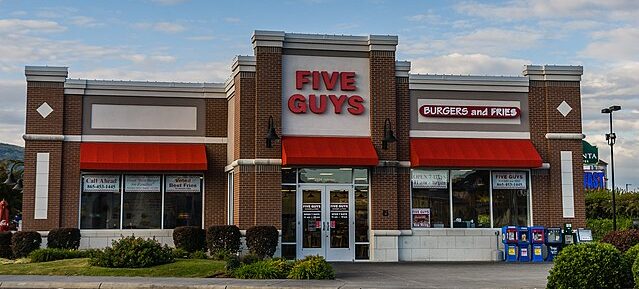Five Guys: Patties and Profits
When I write these Fast Food Finance articles, I’ve noticed a similar trend. One restaurant is good, it responds to gaps in the markets and then franchises intensely. What if that wasn’t the case though – could a company succeed with an unconventional route to the top? That leads me nicely into talking about Five Guys, the burgers and fries restaurant that used an unusual model to grow into a global success.
The belief was that it was better to do a few things, but really well
The story of Five Guys begins in 1986, with a couple called Jerry and Janie Murrell. Speaking to their four young sons, three of whom were close to leaving school, they gave them a piece of advice: “Start a business or go to college.” The family opted for the former, and opened a carry-out burger restaurant in Arlington, Virginia. During the 1980s and 90s, the family perfected their recipes and their simple operating system, opening five locations around the D.C. metro area. Everything was simple, from a basic décor to a simple menu – the belief was that it was better to do a few things, but really well.
Jerry was initially the fifth ‘guy’, keeping his job at AXA Equitable until the restaurant really took off, but that role was soon taken promotionally by a fifth brother, Tyler, when he was born in 1988. All five of the brothers continue to be involved with running the business. Jerry and Janie began offering US franchise opportunities early in 2003, although Jerry expressed great reluctance for fear of compromising on quality (indeed, the initial franchisees were people the Murrells knew, operating on really attractive terms). They had sold options for more than 300 units in just under 18 months. Between 2006 and 2012, the company saw an incredible 792% growth (compared to its closest rival, Jimmy John’s, at 241% over the same period).
The overwhelming success of franchising a local restaurant made national news, and soon opened the door for international markets. Today, there are almost 1,700 locations worldwide and another 1,500 in development. In 2012, it passed $1bn in revenue, and continues to grow. In all this time, there have been few changes to how things run or the menu – the only additions that passed a trial are a few sandwiches and, in 2014, milkshakes.
It’s a case of belief in the product and the quality of the restaurant, and it seems to have worked
There are a number of key differences between Five Guys and other fast-food establishments. The restaurant doesn’t use timers in its kitchen – according to Jerry Murrell, a good cook knows when a burger is done, so there’s no need for them. The burgers are also purposely thinner for a reason. The founders initially experimented with thicker burgers, but the longer cooking times meant that they dried out before they were ready to serve. Five Guys have also declined any delivery options, due to a belief that “it cheapens the product”. The Pentagon famously tried to get food delivered, and the restaurant turned it down, culminating in a 2009 visit to the Arlington store by President Barack Obama.
You may have noticed that Five Guys doesn’t really advertise. The company puts its advertising budget into mystery shoppers – it keeps employees on their toes, ensures that customers have a great experience, and lets the experience and the product speak for themselves. It’s a case of belief in the product and the quality of the restaurant, and it seems to have worked. For staff, the top 200 restaurants each week in terms of mystery shopper goals are given a small bonus to split among employees, further incentivising them.
Five Guys is a fantastic example of putting faith in a good product
None of the ingredients are ever frozen, and the company opts for the best-quality produce, even if that means the price is higher. The buns are baked fresh each morning and toasted on the grill, which is more expensive than a traditional bun toaster, while the peanut oil cooking process helps make the fries less greasy. Although I’ve termed Five Guys ‘fast food’, everything is made to order. Jerry once put a sign outside of his restaurant, stating: “If you’re in a hurry, there are a lot of really good hamburger places within a short distance from here.” It helps the customers see that the wait is intentional, and part of the pay-off for getting a better product.
Five Guys is a fantastic example of putting faith in a good product, using high-quality ingredients, an established and proven system and quite conservative business practices to develop your name. The company went comparatively slowly, taking a lot of risk (with short menus, long waits, etc.), but ultimately, its food was so good that it expanded across the globe. I love the story, and the fact that Five Guys has succeeded without immediately thinking of mass franchising – it shows that there’s more than one way to make your name in fast food.

Comments